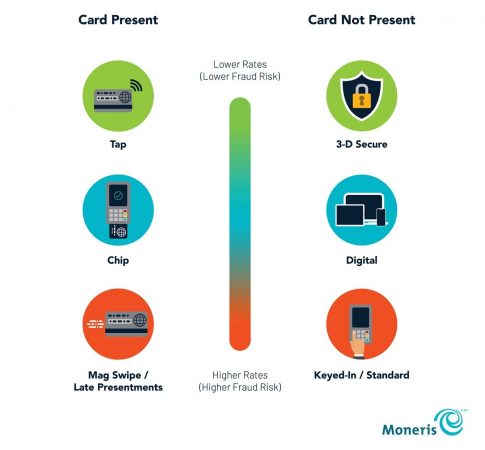
Canadians exposing themselves to fraud with changes in behaviour during pandemic
by CM Staff
Almost 40% of Canadians report experiencing payments fraud or engaged in behaviour that could expose them to fraud since March 2020

Card present vs. Card not present (CNW Group/Moneris)
TORONTO — A new survey from Leger commissioned by Moneris Solutions Corporation found that since the start of the COVID-19 pandemic, 38% of surveyed Canadians have experienced potential fraud or engaged in behaviour that could expose them to fraud. In fact, nearly one quarter (23%) reported that they provided their credit card number over the phone to a store or restaurant, a high-risk activity for both consumers and businesses.
“Canadians are eager to support local businesses impacted by pandemic restrictions, but often unknowingly put themselves and the business at greater risk for fraud by paying over the phone,” says Brian Prentice, Chief Risk Officer, Moneris, in a prepared statement. “When a business can’t prove it is transacting with the actual cardholder, there is no chargeback protection for the business and the transaction is subject to higher processing fees to offset the risk. Fortunately, there are more secure alternatives.”
Depending on how consumers pay, businesses incur higher fees based on the potential risk of fraud. Interchange fees—a per-transaction fee that the merchant must pay to the card issuer each time a customer uses a credit or debit card—are on average an additional 0.5 per cent higher for card-not-present transactions. Manually entering a credit card number has the highest fee across all card brands.
The survey results also reveal that Canadians feel that online shopping is generally safe but they also believe it carries a greater risk of fraud compared to in-person shopping. Sixty-nine per cent feel that shopping online leads to more fraudulent activity, 60% feel safer shopping in bricks-and-mortar stores and 73% believe shopping digitally increases their exposure to fraud. Digital payments are considered higher risk than a payment made in-person but with the evolution of multi-layer identity verification tools, like 3DS 2.0 offered with Moneris Online, consumers are better protected and businesses are charged lower fees so long as their website is properly secured.
The pandemic has caused an uptick in digital transactions, creating more opportunities for fraudsters online. Since March 2020, 14% of Canadians purchased items from an online merchant but never received the items they were charged for. Businesses with an ecommerce solution need to ensure they have the right technology in place to protect their operations and customers from fraud online.
COVID-19 restrictions have led to more online shopping amongst Canadians who are wary of making digital purchases and predominantly shopped in-person prior to the pandemic. There are several factors that impact Canadians’ perception of the security of digital transactions. More than 80% reported at least one factor that influences their online shopping comfort level:
- 63% cited whether the site has built-in fraud and payment protection as a main factor;
- 53% are more comfortable shopping online with a large, recognizable brand and;
- 51% feel better about shopping online if they’re able to remove their credit card information from their online profile.
The look and user experience of the site also influences Canadians’ comfort levels (40%), as well as whether the store has experienced a cyber breach (38%).
“By having a robust online experience that includes multi-layer payment verification and a secure domain, small businesses can help ensure a safer shopping experience for their customers and continue to compete online against big brands,” says Prentice.
Nearly two-thirds (63%) of Canadians feel more confident shopping online due to fraud protection measures, with 79% comfortable making purchases on their computer and 57 per cent comfortable making purchases on their mobile device.